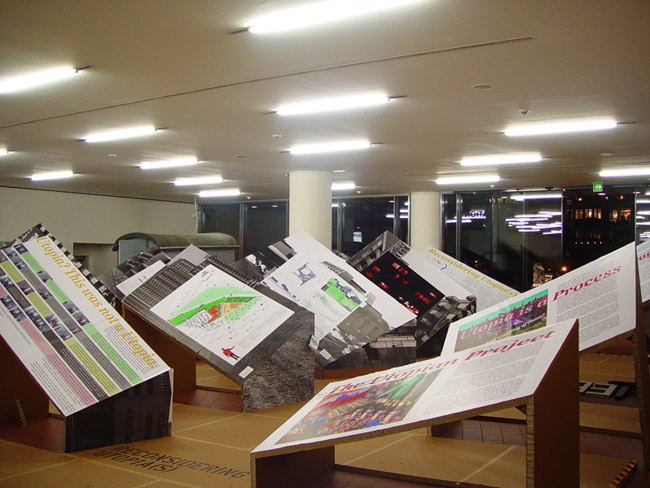
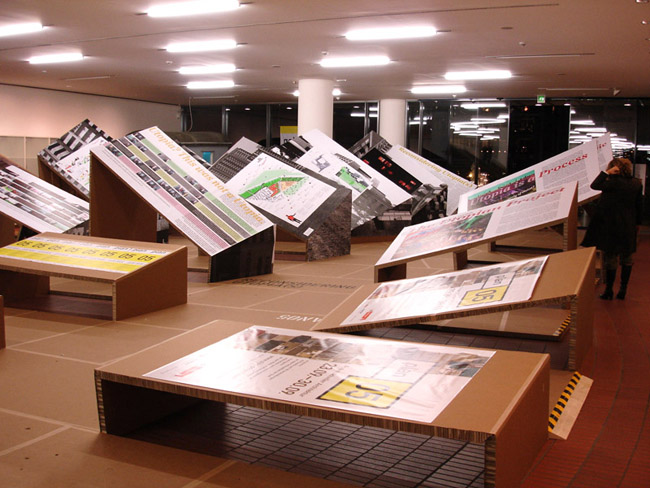
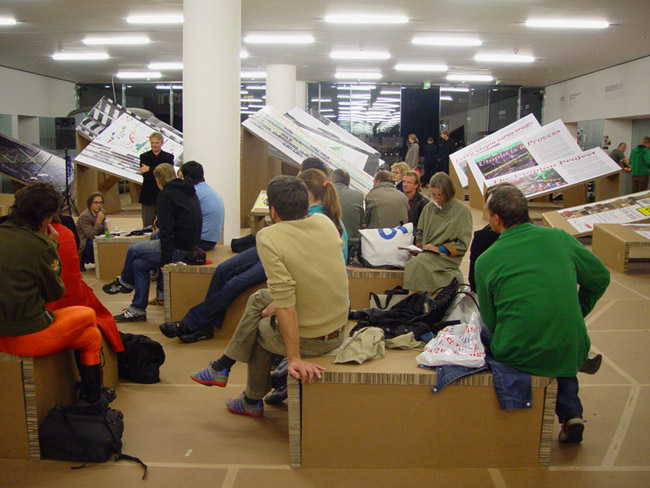
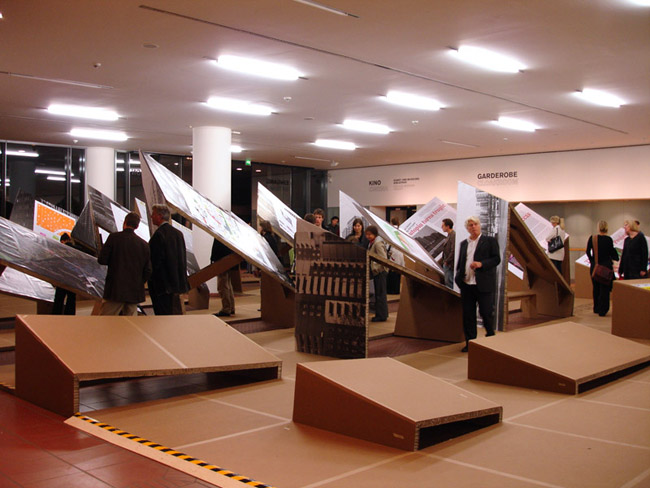
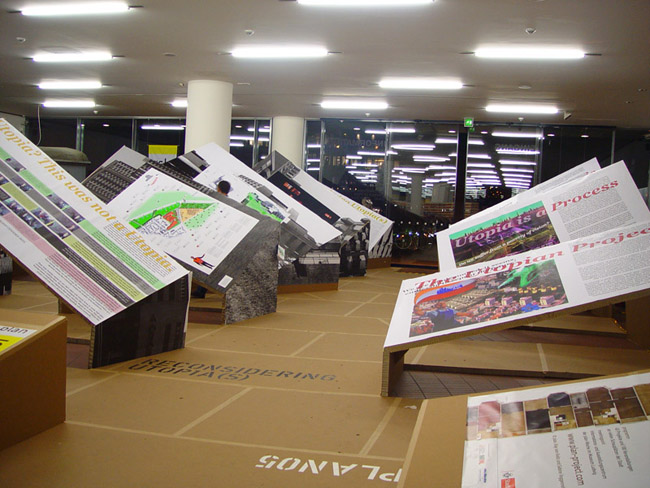
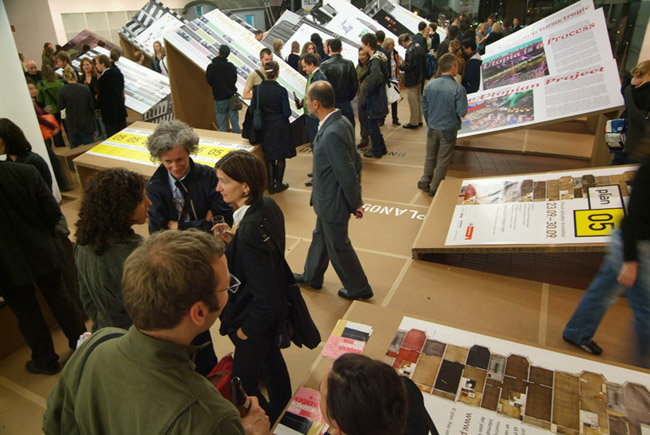
Exhibition at the Museum Ludwig, Cologne
Date: 2005
Planning and Concept: Manuel Herz and Ines Weizman
The Utopian Project
The history of utopia is a history of imaginations and fantasies that rejected the present for a better world. Utopian literature has formed, since modernity, a central part of social imagination, projecting experiments in ideal societies to another time and place. Such were the utopian projects of the 18th and 19th century. The 18th century fascination with utopia went hand in hand with imperial expedition, as an ideological equivalent to the colonizing project, gaining through distance considerable spatial imagination. Following the French Revolution utopia shifted from the realm of literary fiction to the register of politics. In this context it became frequently used as a call for social and political change. Thus before fantasized as a world of ‘otherness’ and oddity the idea of utopia came to represent the ultimate but attainable goal of a vision of history as the story of human progress. It was defined as the end of a linear historical process in which all conflicts, class or national based, would be resolved. Accordingly, present society had to be constructed or reconstructed. Formerly utopian principles of liberty, equality and justice were now incorporated, if seldom implemented, within the political frame of the state.
The transformation of utopia into a political tool marks as well its development from a political and social vision to an urban one. The city and its infrastructure were to be transformed (according to different writers in different manners) and reconfigured to serve the mechanisms of social organization and political control. Architecture was not confined to represent power relations but was consciously employed to constitute them. In as much as political power saw its role in promoting order and hygiene, preventing epidemics and revolts and promoting what is considered as a ‘moral life’, its urban planning tried to create an ‘ideal city’ which sought to embody these principles in matter. In contrast to early utopias based upon visions of a land ‘nowhere’ or ‘elsewhere’ – in its complete or partial realisation – modernist urban utopias, especially in the post-World War II period provided a myriad of typological ‘solutions’ for the needs of the time. Soon, its meaning eroded and it became more obsessed with ‘resolving’ the needs of the present than ‘projecting’ a vision for the future. Moreover, utopia in its early meaning was an arena in which common ideals and dreams were debated, and where a new society was imagined – not by the ruling power, but by intellectuals and activists – to become the full ideology of the state.
Utopia as a process
Utopia in its intent to reject the past and to aim for radical change exemplifies the myth of modernization. It provides images of alternatives to the present society, and could function as a distant viewpoint from which we could look back at our present. Yet, the utopian idea should not be reduced to statements like: ‘the more distant and more alien to the present society a place is the more utopian it is’. Utopia is not an exercise of thought that tries to describe merely an ‘other’ place. Literary fiction has demonstrated human inability to imagine a world significantly different from ours. While the utopian literature aims to suggest ways that could liberate us from the ‘unimaginativeness’ of the present and to rebel against its values, it was, however, described with the language and means of the present. According to Terry Eagleton ‘there can be nothing beyond the limits of what is already known.’ Indeed, Hollywood science fiction movies seek to produce images of a far away and foreign world, but replicate present reality to the degree that it reproduces even the fashion of the time. And thus 1960s aliens tend to be dressed in 1960s fashion. But the question is whether this projection of a future functions as a critique to the present? Similarly, can we take urban utopia as a challenge to the present order even if we know that we can never attain, or even for that matter imagine a real utopia? Marx’s critique of property in which he claimed to eliminate social hierarchies and individual injustices was initially a structural diagnosis of society. Science fiction seems to extrapolate the present into a future, but the power of utopia is its diagnostic and critical-substantive role in the present, as such it helps to reinforce the actual world. Here a possible answer is that the core of the utopian project is a reflection upon present conditions, and thus describing a future as an extension of the present may simply make it more attainable.
The war-torn 20th century allowed, after each catastrophe anew the empty slate of a utopian outset. Utopia is a vision, which can never be realized within the limits of the present. A state of destruction in the present is the very condition for state-managed utopian aspiration, or at least utopian rhetoric. Destruction thus embodies a Faustian promise: the destruction of the ‘old world’ becomes the condition for the construction of the new.
The empty slate
The project Reconsidering Utopia(s) seeks to bring us back to this Faustian moment of choice, to the moment of beginning and to the potentials and dangers that it holds. It tries to recreate the fascination which once captured architects, planners, politicians and the general public – a sentiment which these days is overlooked or ignored. In our work on this project we experienced the softening of language: from describing a particular project as ‘utopian’ (global aspiration relating to human nature and society), it has gradually shifted to ‘a visionary’ one (an original and path breaking approach to a more specific problem), and further to ‘a modernist ideal’ (a term which relativises and historicises the utopian) and finally to the a rather nebulous ‘a utopian moment’ (placing it in the context of a different time). This rhetorical and semantic sequence has fascinated us in revealing a changed attitude to utopia and triggered this project. In this sense the endeavour of this project reads somehow paradoxical as it aims to bring back to attention these historical moments of possibilities and the initiated urban imaginations and projects they implied, while, simultaneously, surf riding on their myth.
In view of the fate of liberal and left leaning political thought and the death of the utopian ideals that once fueled these politics, it seems important to restore the socio-political aspects of urban projects. In a world that has run out of political ideas and no longer harbors any utopian vision, real political opposition seems more difficult. We think of utopia as a way of voicing critique in matter, as less as a utopia of form, but more as a utopia of process, describing the way things work, interact and inter-relate. We believe that utopia must not have a clear form or image, but that it is a story that needs to be told – one that can be told in different ways, one that should be told again. We want to bring back the concept of utopia into our professional domain. Rather than a fiction of a depicted reality in the future, utopia could be a guiding idea that should lure over our design decisions and that should force us to critically discuss, diagnose and dissect the mechanisms of concrete circumstances, situations, and power struggles helping t0 develop a socio-political as well as an urban vision and program. ‘This’, as Frederic Jameson, claimed ‘clearly does not mean that, even if we succeed in reviving utopia itself, the outlines of a new and effective practical politics for the era of globalization will at once become visible; but only that we will never come to one without it.’
‘Circumscribing’ thus the myth of utopia and using its impulses to develop not only visionary projects and objectified procedures in space, but also practices, rhythms and perceptions of space may open up a new field of possibilities for planning. For, in as much as there can never be – and should never be a single architectural form of the city, there can never be a single architectural form for a utopian vision of the city. Therefore we propose to use the concept of utopia as a process, a path towards an end, a complicit set of principles that governs architectural and urban projects and design strategies, principles that inform, but do not dictate the many possible expressions of design. In this sense we would ask: How do we understand the modernist legacy in our cities? How do we cope with the dilemma of utopia? How can we re-formulate and re-vive the visionary potential that is inscribed into the architectural form? And what does utopian thinking mean today for architectural and urban practice?
‘Reconsidering Utopia(s)’
‘Reconsidering Utopia(s)’ aims to investigate particular instances of ‘visionary’ building projects of the post-war period in the Federal Republic of Germany. These projects were conceived under the growing pressure of housing need but aimed as well to embody the 1960s and 1970s ideology of social-democracy. These projects aimed to address mundane issues of infrastructural improvement, provision of services and cultural facilities. These were aimed at the sections of society that had problems in getting access to housing, amongst them, and increasingly so since the 1960s, a large numbers of immigrants and guest workers.
The case studies of this investigation are varied. They vary both in the period of their construction and in their program. One of the case studies examines the Cologne Opera, one of the most significant public buildings of the post-war period. It was the first modernist structure to grow out of the rubble of the war-ravaged inner city of Cologne. While in the 1950s it marked the moment of departure into an imagined brighter future of a new democratic Germany, today the future of the partly neglected building and its surrounding is heavily debated. Another case study deals with the large retail market (Grossmarkt), a structure which in the 1960s was extended to respond to the needs of the growing population of Cologne, and is now awaiting further extensions, relocations and transformations to cater for an even larger urban region. We aim to test the market for its economic, spatial and cultural potential for the city of Cologne. Yet another case study seeks to investigate the ring of high-rises surrounding the city of Cologne. It was planned and built in the 1960s and 70s to outline an edge for the inner-city and to mark the large traffic interchanges. Yet, what was once thought to represent the confident future of the city appears to the ‘preservationists’ of today to uncomplimentary rival the position of the Cologne Cathedral in dominating the city’s skyline. Another case study investigated the possible future for the eastern bank of the Rhine, opposite of the Cologne Cathedral. This relatively large plot of land had remained untouched since the end of the war and had since been ‘protected’ by urban planners to provide green, open space for public events and to offer views towards the eastern bank of the city. In contrast to the others, this case study was meant as an investigation of present day’s capacity to develop a new societal organization – utopian as it may - not on the built, but on ‘virgin land’. Lastly we were concerned to investigate the modernist legacy of the large-scale housing estates of Cologne-Chorweiler and of Cologne- Meschenich. Both in the intention that guided their inception as well as in their fate, these estates are similar to many other projects in Europe. In recent years these large-housing schemes became increasingly disliked, avoided and for a long time neglected. And yet, they have remained sites of large proportions of a population who could not afford to move elsewhere and who found in these estates their home.
A closer look at well-known prejudices directed at housing estates, depicting them as monotonous, repetitious, or anonymous might often reveal that, previously misunderstood and underestimated social transformations are taking place in those housing estates. While in the 1970s it was considered enough to simply paint some facades, arrange some green and to add a few balconies, today “regeneration” has to be reconsidered. Today we often see city administration looking helplessly (if at all) at those housing estates, not able to grasp the new social and spatial configurations of a dynamic society that constantly changes the ‘profiles’ of its inhabitants.
To understand and support their needs – rather than repeating the conventional models of the bourgeois urbanism of the ‘core city’ or, even worse, this of sprawling suburbia – we need to find a new language and new approaches to grasp the dramatic changes German cities have undergone as part of the New Europe. These large housing estates on our city’s edges will remain home to many and cities would have to address them. We tried to investigate how this could be done, how these housing estates could better respond to their need. And yet, despite its commitment this project could only start a discussion which hopefully will be continued.
Text: Manuel Herz and Ines Weizman